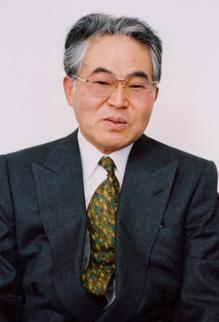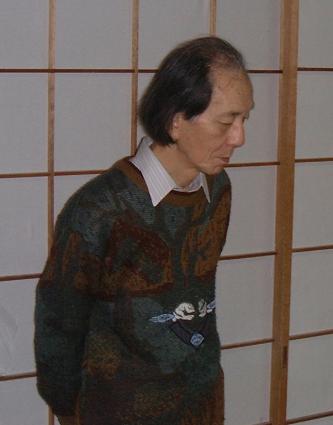
Tournaments | Others | Famous Japanese Go Schools: Ryokusei by Kikuchi, 8-dan ama
WHITE


BLACK

2012-01-03
Expert: breakfast
Famous Japanese Go Schools: Ryokusei by Kikuchi, 8-dan ama
The Ryokusei Academy
Kikuchi Yasuro, ama 8d is the owner of the biggest Japanese Go school
Born in 1929 in Tokyo, Kikuchi has won over 20 amateur titles, and so qualifies many times over for the new status of 8-dan amateur. He probably could have been a pro himself, but chose instead to stay with a small steelworks during his working life. Since retirement from that job, however, he has kept himself in full-time employment by running the Ryokusei Academy in Shibuya Ward in Tokyo which he founded in 1975.
It has arguably been the most effective school for producing professionals apart from the schools of Kitani Minoru, 9-dan and Kubouchi Shuchi 9-dan, but what is not in doubt is that it is the one enjoying greatest success now.
The Academy began with ten students, mostly university students. In the second year, promising schoolchildren of any age were allowed in. In its fourth year (1982) it had its first major success when Muramatsu Ryuichi, now 7-dan, became a pro from its ranks. There was also Maeda Ryo, now 6-dan, though he later joined the school of Ohira Shuzo 9-dan pro.
In 1988, Yamashita Keigo (he is nowadays one of the top Japanese professionals and Kisei titleholder) was another graduate, having joined when in primary school (he went on to become Primary School Meijin too). Yamashita went to Tokyo all the way from Asahikawa City in Hokkaido, so as you can see the Ryokusei Academy had become a boarding school, having had to expand its premises to a whole house in Nakano Ward in 1992.
The successes of graduates have multiplied recently. For example, Aoki Shinichi, 9d won the Shunei and Miyazaki Shimako and Osawa Narumi both won the Women's Kakusei, and Yamashita also has several minor titles under his belt. Akiyama Jiro 8-dan and Mizokami Tomochika 8-dan are other senior graduates.
But there are other features which distinguish the Ryokusei Academy apart from such tangible successes. One of the most important in the longer term, probably, has been the way it has forged links with similar academies in China and Korea. An early link-up was with China's youth squad in Beijing, exchanges continuing for three years.
The Academy was then forced by its own success to move yet again, or rather to branch out, this time to Setagaya Ward in 1996.
At the time of writing, these overseas link-ups were still in full swing. May 2000 saw the second match between the Ryokusei Academy and the Heo Academy in Seoul. The Heo Academy is Korea's most famous training school for go pros and is run by Heo Chang-heui (Alexander Dinerchtein, 3p also attended it). Unlike Kikuchi, Heo is still an active pro, born in 1954 and making 8-dan in 1996, but before becoming professional Heo showed outstanding results on amateur Go scene, like Kikuchi did. His school is purely for children and is run in a rather more regimented way than is usual in Japanese go schools, with a tailored programme of events reinforced by having classrooms devoted to those activities. But it is successful and includes Kim Myeongwan 9p, An Yeongkil 8-dan and Park Chungsang, 9-dan among its alumni - all teenagers cutting a swathe in domestic events.
Also at the time of writing, the Academy had 14 pros, 13 inseis and 80 amateurs on its rolls. Of all the new pros enrolled in the Nihon Ki-in in the last five years, the Academy has been the top supplier with five, ahead of Cho Chikun's school (four) and Kobayashi Koichi's (three).
It is hard to say what makes one school better than another, but Kikuchi's Academy is not, on the face of it, especially innovative. The players all play each other in a league, they study both ancient and modern games, and Kikuchi himself stresses not just the refinement of on-the-board skills but also decorum and stamina.
These are core disciplines that have characterised his own go-playing career. His achievements have been enough to warrant a book of his own games published by the very distinguished publishing house Seibundo. Here is one of Kikuchi's games against Japanese top pro Otake Hideo (on 2 stones handicap)
A quick resume of Kikuchi's career may be useful here. He learnt go at three, was a regular player at an all-day Sunday club at age 7 and by the time he entered Junior School (1942) he was amateur 2-dan. Because of the war he moved out to Yokohama in 1943 and there was able to study with Koizumi Shigero 5-dan, Morikawa Masao 1-dan and Fujisawa Kuranosuke 7-dan. By the time he went to university to read economics (1947) he was amateur 5-dan. He entered the first amateur championship after the war and reached the semi-finals, but more importantly was noticed by the legendary Yasunaga Hajime, author of Shin Fuseki. He began his working life in 1953 but went on to win the Amateur Honinbo 10 times.
Some photos from Kikuchi school by Jerome Hubert:
http://jerome.hubert1.perso.sfr.fr/Go/Histoire/TokyoOct2003/tokyo_02.htm
The Ryokusei Academy
Kikuchi Yasuro, ama 8d is the owner of the biggest Japanese Go school
Born in 1929 in Tokyo, Kikuchi has won over 20 amateur titles, and so qualifies many times over for the new status of 8-dan amateur. He probably could have been a pro himself, but chose instead to stay with a small steelworks during his working life. Since retirement from that job, however, he has kept himself in full-time employment by running the Ryokusei Academy in Shibuya Ward in Tokyo which he founded in 1975.
It has arguably been the most effective school for producing professionals apart from the schools of Kitani Minoru, 9-dan and Kubouchi Shuchi 9-dan, but what is not in doubt is that it is the one enjoying greatest success now.
The Academy began with ten students, mostly university students. In the second year, promising schoolchildren of any age were allowed in. In its fourth year (1982) it had its first major success when Muramatsu Ryuichi, now 7-dan, became a pro from its ranks. There was also Maeda Ryo, now 6-dan, though he later joined the school of Ohira Shuzo 9-dan pro.
In 1988, Yamashita Keigo (he is nowadays one of the top Japanese professionals and Kisei titleholder) was another graduate, having joined when in primary school (he went on to become Primary School Meijin too). Yamashita went to Tokyo all the way from Asahikawa City in Hokkaido, so as you can see the Ryokusei Academy had become a boarding school, having had to expand its premises to a whole house in Nakano Ward in 1992.
The successes of graduates have multiplied recently. For example, Aoki Shinichi, 9d won the Shunei and Miyazaki Shimako and Osawa Narumi both won the Women's Kakusei, and Yamashita also has several minor titles under his belt. Akiyama Jiro 8-dan and Mizokami Tomochika 8-dan are other senior graduates.
But there are other features which distinguish the Ryokusei Academy apart from such tangible successes. One of the most important in the longer term, probably, has been the way it has forged links with similar academies in China and Korea. An early link-up was with China's youth squad in Beijing, exchanges continuing for three years.
The Academy was then forced by its own success to move yet again, or rather to branch out, this time to Setagaya Ward in 1996.
At the time of writing, these overseas link-ups were still in full swing. May 2000 saw the second match between the Ryokusei Academy and the Heo Academy in Seoul. The Heo Academy is Korea's most famous training school for go pros and is run by Heo Chang-heui (Alexander Dinerchtein, 3p also attended it). Unlike Kikuchi, Heo is still an active pro, born in 1954 and making 8-dan in 1996, but before becoming professional Heo showed outstanding results on amateur Go scene, like Kikuchi did. His school is purely for children and is run in a rather more regimented way than is usual in Japanese go schools, with a tailored programme of events reinforced by having classrooms devoted to those activities. But it is successful and includes Kim Myeongwan 9p, An Yeongkil 8-dan and Park Chungsang, 9-dan among its alumni - all teenagers cutting a swathe in domestic events.
Also at the time of writing, the Academy had 14 pros, 13 inseis and 80 amateurs on its rolls. Of all the new pros enrolled in the Nihon Ki-in in the last five years, the Academy has been the top supplier with five, ahead of Cho Chikun's school (four) and Kobayashi Koichi's (three).
It is hard to say what makes one school better than another, but Kikuchi's Academy is not, on the face of it, especially innovative. The players all play each other in a league, they study both ancient and modern games, and Kikuchi himself stresses not just the refinement of on-the-board skills but also decorum and stamina.
These are core disciplines that have characterised his own go-playing career. His achievements have been enough to warrant a book of his own games published by the very distinguished publishing house Seibundo. Here is one of Kikuchi's games against Japanese top pro Otake Hideo (on 2 stones handicap)
A quick resume of Kikuchi's career may be useful here. He learnt go at three, was a regular player at an all-day Sunday club at age 7 and by the time he entered Junior School (1942) he was amateur 2-dan. Because of the war he moved out to Yokohama in 1943 and there was able to study with Koizumi Shigero 5-dan, Morikawa Masao 1-dan and Fujisawa Kuranosuke 7-dan. By the time he went to university to read economics (1947) he was amateur 5-dan. He entered the first amateur championship after the war and reached the semi-finals, but more importantly was noticed by the legendary Yasunaga Hajime, author of Shin Fuseki. He began his working life in 1953 but went on to win the Amateur Honinbo 10 times.
Some photos from Kikuchi school by Jerome Hubert:
http://jerome.hubert1.perso.sfr.fr/Go/Histoire/TokyoOct2003/tokyo_02.htm
Comments:
No comments


 back
back

